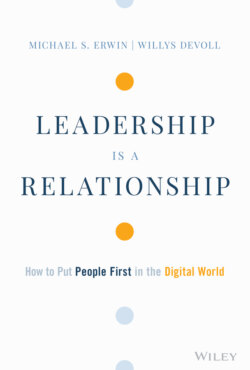Читать книгу Leadership is a Relationship - Michael S. Erwin - Страница 8
Relationship Complexity
ОглавлениеWith new distractions and methods of communication, relationships exist in several different realms: the Facebook friendship, the Twitter reply, the Instagram like, the WeChat thread, the group text, and, you know, the old-fashioned, face-to-face conversation or lengthy phone call. Our not-so-distant ancestors had a couple of ways to communicate with friends and loved ones, and they weren't available at every hour of the day. We, on the other hand, can't even name all of the different options we have for sending someone a message—and each of those channels requires a different style of communication. Speaking a tweet in actual conversation would be bizarre, and the style of an Instagram comment is a whole lot different (and emoji-laden) than what you might send the same person in a handwritten note.
Let's call this dizzying phenomenon relationship complexity: relationships have become much more complex as a direct consequence of the number of communication channels, styles, and expectations that the twenty-first-century economy has produced. Even the most earnest, compassionate, and energetic person has a more complicated social landscape today than they would have just 10 or 20 years ago … let alone 50. Although it's hard to say exactly how much more convoluted relationships have become, the proliferation of information tech has upped complexity by orders of magnitude.
Complexity itself isn't bad, but relationship complexity is very hard to manage on a daily basis. As creatures that didn't evolve beside such overwhelming stimuli, we're understandably struggling. The United States is just one of several developed countries with a well-documented epidemic of loneliness and weakened relationships. The 2020 Cigna Loneliness Survey, one of the most-cited measures of sociality in America, found that 61 percent of Americans are lonely.6 That figure comes from before the pandemic. As Covid-19 shut the world down and forced us to stay in our homes, it also illustrated just how far technology still is from effectively replacing face-to-face relationships. Unlike other kinds of disasters and heartbreaks, the pandemic was cruelly well-suited to threaten our relationships. Shared spaces, from schools to gyms to community centers to restaurants, shuttered. Many haven't and won't return. Weddings, funerals, and bedside consolation for the sick—age-old rituals of connection—became impossible. A huge number of jobs became remote positions. It's important to reiterate this particular torture of the pandemic: on top of all of its monstrous tolls, it exponentially accelerated the trend away from communal, face-to-face experiences and toward physical and emotional isolation. What the smartphone created, the pandemic amplified.
As we dive deeper into our own personalized digital worlds, social and political polarization continue to rise and threaten not only our social institutions, but also our sense of common purpose. And, of course, understanding and adapting to technological innovation is hard because technology just keeps changing. With the convergence of both the overstimulation and pandemic crises, we're beginning to appreciate in vivid detail just how much 24/7 information overload has affected us.
It's disingenuous to present the problem du jour as both terrifying and unprecedented. The old “kids these days …” quip highlights the very real phenomenon of recency bias—as humans, we tend to overstate the importance of what just happened, and the threat of technology's intrusion into our personal lives is no exception.7 Without panic or hyperbole, we want to convince you that the conditions of modern, plugged-in life pose a powerful but nonetheless addressable threat to creating and growing relationships. The average American already watches TV four times longer each day than they spend socializing and communicating with others.8 Our everyday interactions and pastimes are filled with devices and systems that didn't exist even 15 years ago, and compelling new inventions hit the market more than ever.
The history of humanity is rife with challenges, many of which we've overcome. We're not interested in fear-mongering or hand-wringing. These particular challenges to relationship-building, though, are new and distinctly ours. We can surmount them, but first we need to understand and define them.
